Ever wondered what’s going on underneath the sparkling Maldives ocean? From mammals to molluscs, the marine life that inhabits the Maldives waters is diverse and is held together by the spectacular Maldives coral reefs. These coral reefs provide a uniquely diverse and valuable ecosystem, that play an essential role in everything from water filtration and fish reproduction to shore line protection and erosion prevention.
Coral reef conservation is therefore of utmost importance for the Maldives and at Constance Hotels & Resorts we are very much engaged in protecting these beautiful coral reefs by trying to encourage a responsible tourism.
In this article, we break down the importance of corals for the Maldives marine life, how they can thrive, and how we are supporting the preservation of these enchanting reefs.
Why is Coral Reef Conservation so important?
Did you know that coral reefs are one of the most valuable ecosystems on the planet?
Coral reefs are capable of producing half of the oxygen we breathe and of creating the biggest structure made by living organisms that can be seen from space. Their complex three-dimensional structure harbours the biggest number of marine species per unit area when compared to other marine ecosystems.
It is like a small busy city where other animals and plants find shelter, food, or a partner to mate. Coral reefs also support fishing and tourism industries, protect the shoreline, and help fight climate change, among other key functions.
To help preserve and restore these amazing underwater ecosystems, more and more initiatives are being taken in the Maldives and across the world. The most effective measure to safeguard coral reefs and all the organisms that depend on them is the establishment of marine protected areas (MPAs). Marine protected areas are established to shield threatened marine ecosystems and other undersea resources from intrusive human activity. Additionally, these protected areas also provide living laboratories for oceanographers and marine biologists to conduct valuable research.
How does Constance Moofushi contribute to Maldives Coral Reef Conservation?
Apart from a coordinated global coral reef conservation strategy, smaller local-scale restoration projects can also contribute a lot to preserving the reefs.

The coral restoration project at Constance Moofushi was initiated at the end of 2017 in partnership with Reefscapers, the leading coral restoration organisation in the Maldives.
The project’s target is to help restore the natural coral reefs surrounding the island by growing corals on iron frames. The project uses branching corals, which grow faster and are easier to collect than the massive corals.
The small coral pieces are attached to the bars of the frames with cable ties and generally start growing after a few weeks. In approximately three-years’ time, and if no major events disturb the corals (for instance, a wave of coral bleaching), the whole structure will be covered by colonies! These colonies then become the source for even more coral planting.
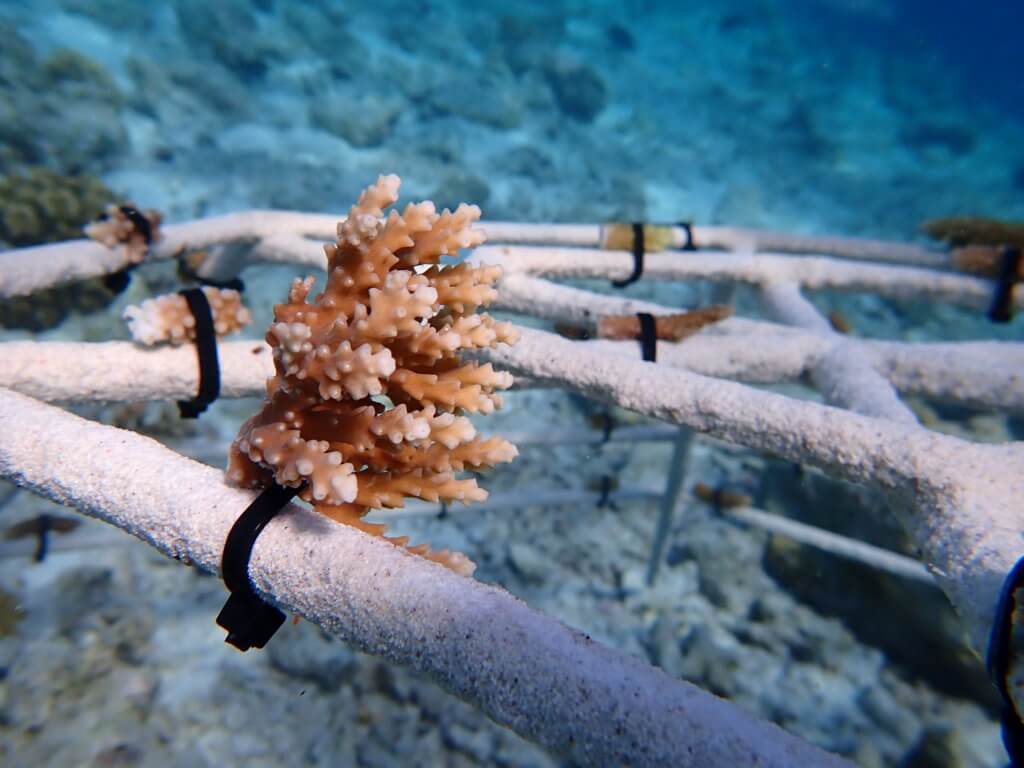
The frame becomes part of the natural reef, but pieces of colonies can also be detached from it and placed back onto the degraded reef.
Guests visiting the Constance Moofushi resort are among the main sponsors of the project. They can purchase the frames and directly attach the corals on it before placing them in the water. All this of course under the supervision and guidance of our resident marine biologist in charge of the coral conservation project.
The small monetary benefits of the project are reinvested. For instance, for planting more frames into the sea, inviting specialists in the field to the resort or organizing a coral conservation day for local kids.
Moreover, the project has also a small social component because the frames are constructed by fishermen from a local island called Fulhadhoo in Baa atoll. Currently, there are 135 frames in the water divided into two main areas: the drop-off and the arrival jetty.
Have you seen any of these coral restoration projects during your travels?
How long does it take for a coral to recover?
When corals are stressed, for instance, when the temperature of the ocean rises, they can turn white (bleaching). The reason for this coral bleaching is the loss of the microscopic algae living inside of them (zooxanthellae) due to the stressful conditions.
Zooxanthellae are not only responsible for the amazing colours of the corals but provide most of the food corals need to survive and grow. The survival of coral reefs depends on their resistance to bleaching, tolerance to survive a bleaching event and the level of recovery they display.
Every coral colony has a different set of genes and is surrounded by different environmental factors; hence, it becomes very difficult to predict the outcome of a bleaching event.
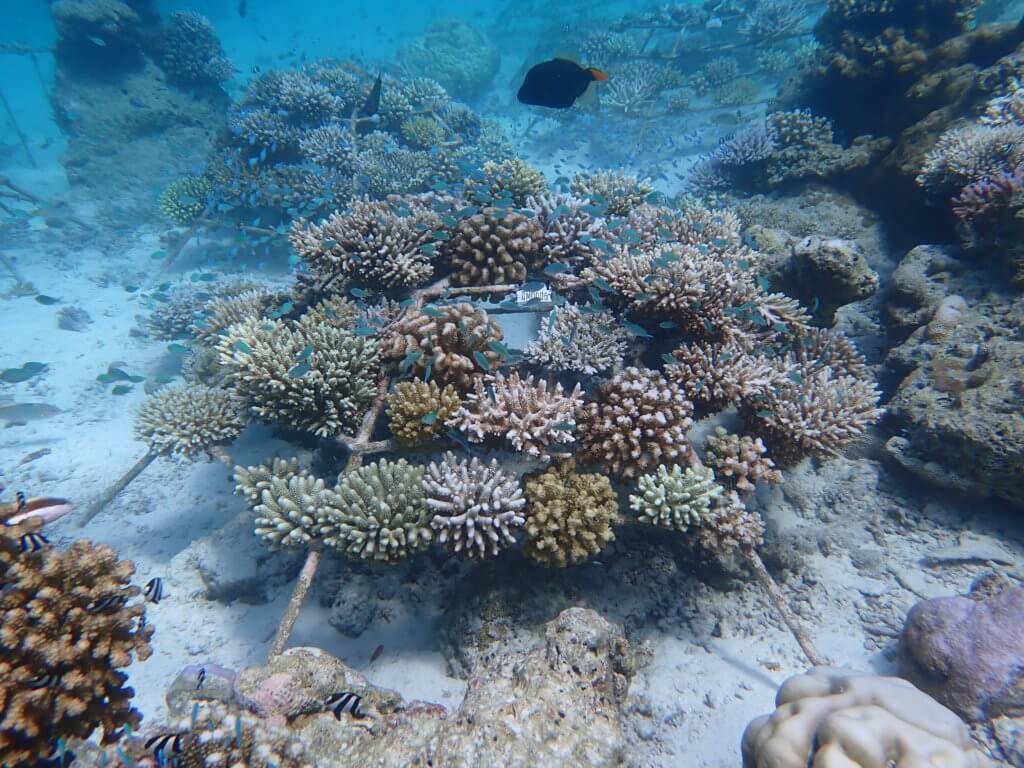
Due to climate change, the frequency of bleaching events has increased dramatically in recent times, and other stressing factors such as ocean acidification or water pollution are also increasing. If the stressor is removed in a short period, corals are potentially capable of uptaking new algae and survive.
However, if the stressor stays for a long time, it becomes hard for corals to go back to normal and survive.
Even if they survive a bleaching event, the overall health and capacity of the reef to reproduce is hindered. Some experts point out that after a major bleaching event, it takes around 5-10 years for corals to fully recover. But as mentioned above, this is quite difficult to predict, and it can never be assured it will come back to the previous state.
It may be a long road ahead, but let’s do all we can to help these corals bloom back into their prime condition. 😊
Do corals need sunlight to grow?
Many corals, including all the reef-building corals (those capable of creating the living limestone structures called coral reefs), contain photosynthetic algae, called zooxanthellae, that live in their tissues, forming a very successful relationship know as symbiosis.
Both organisms highly benefit from this relationship. The coral provides the algae with a protected environment and compounds they need for photosynthesis. In return, the algae produce oxygen and help the coral to remove wastes. Most importantly, zooxanthellae supply the coral with important nutrients, which are the products of the photosynthesis.
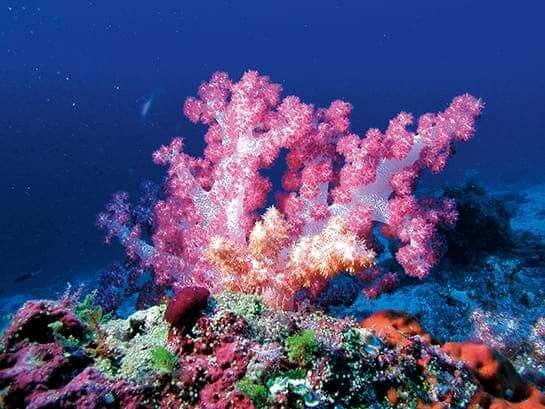
Since algae need sunlight to do the photosynthesis and survive, we could say that indeed corals need sunlight too. Especially, if we consider that the nutrients provided by the algae cover almost 70% of the coral’s needs. Hence, without this relationship between them, there would be no coral reefs in the world.
This also explains, why corals can even thrive in poor waters that are low in nutrients. The remaining 30% of the necessary nutrients, corals get from sieving seawater with their tentacles. We don’t know about you, but our mind is blown with all this amazing information about coral reefs!
What is the rarest coral?
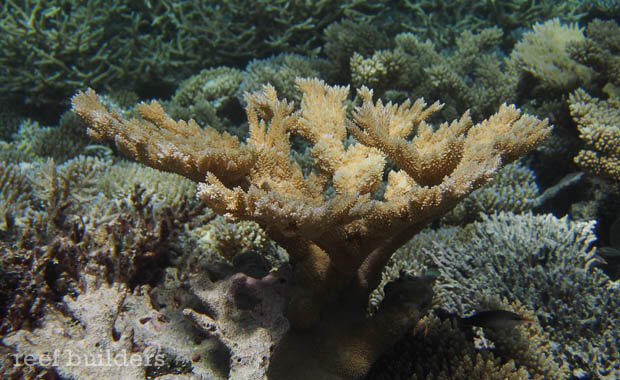
In 2010, during an underwater survey in the remote North Pacific, specifically in the Arno atoll in the Marshall Islands, scientists discovered what could be the world’s rarest coral. It looked very similar to the critically endangered Elkhorn coral (Acropora palmata) of the Atlantic Ocean, but genetic analyses made clear it was the Pacific Elkhorn coral (Acropora rotumana).
This species had not been spotted in over 100 years and it could be the same once described in Fiji Islands in 1898, but no reliable data was gathered at that time. If you spy this coral make sure you get a snap of it!
What is the role of the Marine Biologist at Constance Moofushi?
The marine biologist Estrella Gonzalez Tapias, manages the whole coral restoration project at Constance Moofushi. Four times a week she gives a speech on marine life in the Maldives focusing on the importance of conservation strategies not only for coral reefs but also for manta rays, sea turtles, whale sharks and marine life in general. Twice a week she leads the “Introduction to Moofushi reef”, and a presentation on marine life of the surrounding reefs.
She also takes guests on guided snorkelling trips to spot as much marine life as possible, joins as many whale shark trips as possible to enhance the guests’ experience and answer their questions. She is also always around to meet guests and exchange knowledge with them.
So be sure to ask her any marine questions you have!

Estrella and the Constance Moofushi’s team are also working on a number of other projects, like, starting our own sea turtle database to study the cetacean population near Moofushi, publish our own guide to our reefs with photographs taken here or broaden our collaboration with local NGOs such as Olive Ridley Project or Manta Trust! Talk about a dream job!
Have you ever been part of a coral restoration project? Are you feeling inspired to explore more of the ocean? Let us know in the comments below!
Feel free to reach out via our social channels and share your photos with the hashtag #MyConstanceMoment
Hope for sunnier days with #ConstanceWithU
Facebook: facebook.com/constancehotels
Instagram: Instagram.com/constancehotels
Twitter: twitter.com/constancehotels


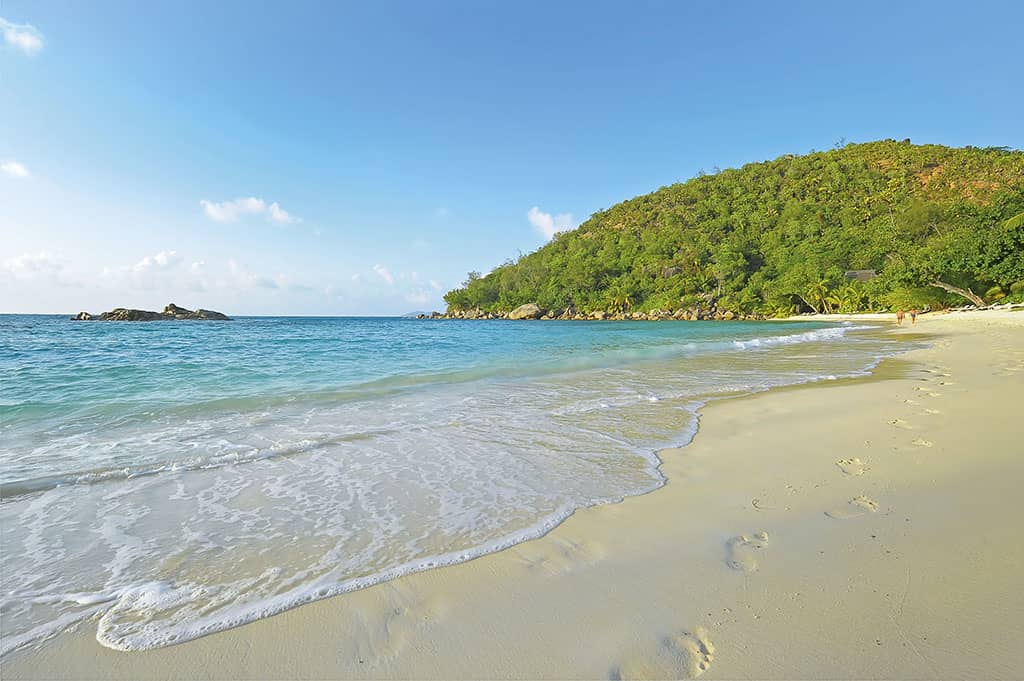

1 Comment
David and Sarah Faulkner
June 30, 2020 at 3:55 pmA great article, we visited in March for our Honeymoon and decided to sponsor a frame in the name of our two dogs Frank and Honey.
It’s been built and launched, with just the nameplate to be attached. We’ve already had some photos and an update from Estrella and are so excited to come back soon to see how it’s doing ourselves.
A great project with a great custodian in Estrella!